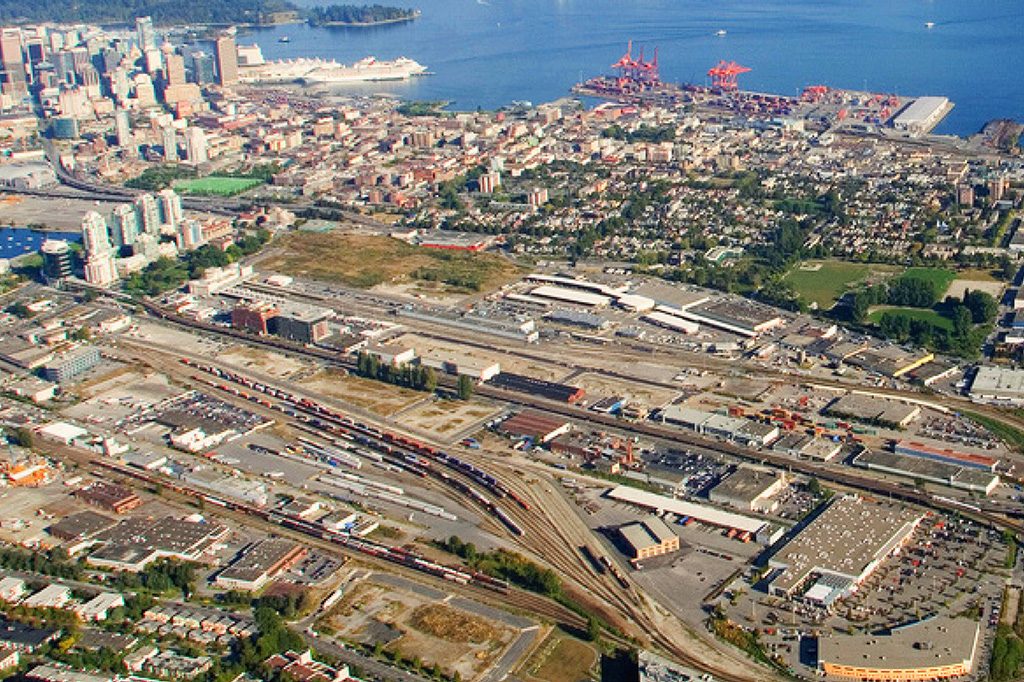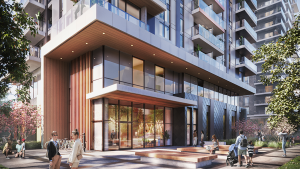A Vancouver neighbourhood is reconfiguring its transportation options to better preserve its character while maintaining commercial trade and vehicle mobility.
False Creek Flats is located just east of downtown Vancouver, south of the Port of Vancouver and is home to both residences and over 600 businesses. The area is also the future home of a new location for an expanded St. Paul’s Hospital to replace the aging downtown facility.
Separating streets from the Burrard Inlet Rail Line is part of the City of Vancouver’s Transportation 2040 Plan and False Creek Flats Rail Corridor Strategy. Currently Prior Street acts as an arterial through False Creek Flats but a new arterial route would allow for an overpass above the rail line.
The City of Vancouver completed the False Creek Flats Plan in 2017, a long-term vision for the area to become more productive, sustainable and connected to the rest of the city. There was no clear preference for an arterial route for traffic during the planning process and the task of selecting a grade-separated arterial route was given to the Flats Arterial Community Panel, a randomly selected group of Vancouver citizens. The panelists viewed presentations from city planners, business and transportation associations and other experts.
The panel’s recommendation, issued on April 6 after three rounds of deliberation and consideration of five different options, was a grade-separated route starting at National-Charles and ending at Main Street. The route was chosen because it had a lower negative impact on businesses and moved arterial traffic further away from residential areas. It also preserves local community gardens and existing parks and allows for more flexibility in road design.
“We considered a substantial amount of technical information, presentations from stakeholders, responses to our questions, and each other’s perspectives and values in order to weigh the trade-offs of the route options under consideration. There were many factors to comprehend and consider, and though at times the process felt rushed and frustrating, it was also collaborative, productive, respectful, and ultimately transformative,” a statement from the panel said in the final report.
Key to reconfiguring the neighbourhood’s traffic at and above grade is prioritizing safety, City of Vancouver manager of transportation planning Dale Bracewell said. Bracewell was also one of the presenters to the Flats Arterial Community Panel.
“All the things we need to do are safety improvements. Unfortunately, not everyone pays attention to the rail crossing, and it doesn’t run 24 hours. We even have videos of people hopping over trains while carrying bikes. We really need to formalize safety around these crossings,” Bracewell said.
While motor vehicle access is important, Bracewell said every mode of transport is a priority.
“In addition to an arterial that works for cars, buses and trucks we’re also looking at the overpass for pedestrians and cycling,” he said.
“What’s mostly achieved is ‘safety for all.’ By continuing to have an arterial, many want ‘shortcutting’ traffic to be reduced, and the main tool we have is making sure we have some arterials so they use those routes,” Bracewell added.
“Grade separation won’t attract more cars, but when people do need to drive, the grade separation will help them to stay the course and choose the arterial,” he said. “It also helps local traffic because it acts as a collective for them.”
Bracewell said planning to reconfigure the neighbourhood’s various modes of traffic has been a long-term project.
“The project goes back over a decade. We first commissioned a study to understand how to better support the local economy and the jobs that come with a port city, and rail is one part of how to move goods,” Bracewell said.
In October 2008 the False Creek Flats Rail Corridor Strategy was completed, with participation from Port Metro Vancouver, the Greater Vancouver Gateway Council, TransLink, Better Environmentally Sound Transportation, and the Vancouver Area Cycling Coalition. Rail grade separation on Powell Street through construction of an overpass was deemed to provide the best overall benefits for rail, vehicle traffic, and cycling, pedestrian and transit improvements. In 2014 the Powell Street overpass was completed.
He added there are federal standards that must be adhered to, which includes closing access streets to streamline traffic and allow routes for loading and unloading of goods.
“It’s not just for the community but also for industrial use, and grade separation is one of the solutions the federal standards say is acceptable and preferable,” Bracewell said.
“We did community consultation, which needs to be presented to the Parks Board and city council,” he said. “We’ll have a final recommendation (from the city and Parks Board) between now and the end of 2019.”











Recent Comments
comments for this post are closed